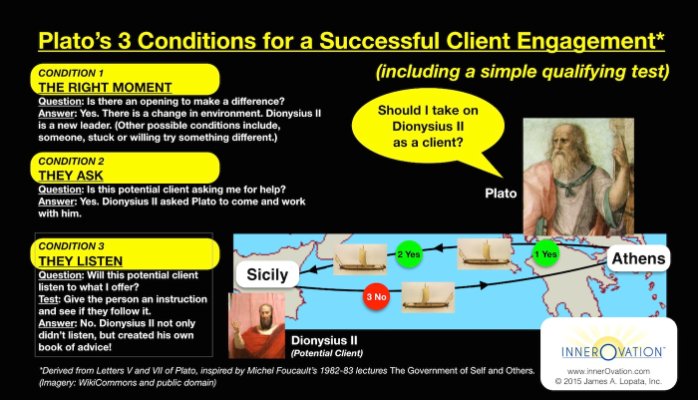Plato’s 3 Conditions for a Successful Client Engagement — including a simple qualifying test.
Ever work with a client who ends up being a complete tyrant?
Plato did.
He had a really, really bad client experience. And when I say really bad, I mean, he barely escaped with his life.
He literally worked with a tyrant—Dionysius II of Sicily.
I’ve had my own encounters with nightmare clients. I’m happy that none them pursued me wielding swords!
Fortunately Plato lived to tell about his tribulation. And in his Seventh Letter he describes his ordeal and the lessons he learned. These serve as Plato’s conditions for a successful client engagement.
In the hopes of staving off another couple of millennia of unwarranted service provider-distress, I herewith summarize Plato’s three conditions for a successful client engagement.
CONDITION 1: Find the right moment.
“It’s just not the right time for me.”
How often do salespeople hear that in a variety of forms from potential customers? Very often. What makes someone ready? It’s about finding “a suitable opportunity,” says Plato. What makes a suitable opportunity? Plato found it in moments of discontent and/or change. When Dionysius II came to power, there was a change in governance. This presented an opportunity.
As an entrepreneurial coach, I find opportunities when a business owner wants to make some big changes, when they may be changing ownership, or product lines, or are experiencing market turmoil, or are growing so fast that they can’t keep up. I also find it when people are stuck. These are openings.
When someone starts poking around, they are looking for change. It’s a prime moment for a possible successful client engagement. But it’s not the only condition.
Plato saw an opening for change in Athens in his youth, when the government was going through massive transitions after the Peloponnesian War. But that engagement didn’t satisfy Plato’s second condition: Find someone who says they want your product or service.
CONDITION 2: Find someone who says they want what you’re offering
“Whenever anyone consults me about any of the weightiest matters affecting his own life,” Plato writes, “or if he seems likely to listen to advice about the things on which he consults me, I advise him with readiness, and do not content myself with giving him a merely perfunctory answer. But if a man does not consult me at all, or evidently does not intend to follow my advice, I do not take the initiative in advising such a man, and will not use compulsion, even if he be my own son.”
Pretty straightforward and seems fairly obvious, right? And yet, when I think about it, how often have I found myself offering my assistance to someone who hasn’t asked for it? How many times have I seen someone who clearly needs my help, and I go over to assist them, and they give me a nasty look?
I think of the time when I was younger and I saw an elderly person having trouble crossing the street. I quickly rushed over and offered my hand to her. I’ll never forget the look on her face as she turned up toward me with a sneer and said, “Young man, I am perfectly capable of taking care of myself.” She snapped her arm from me and hobbled away in disdain.
Lesson learned: If not asked, don’t offer!
There was a big opening in Athens for Plato’s assistance, but they didn’t ask him for help. And Plato didn’t offer.
Dionysius II, on the other hand, did ask for Plato’s assistance. So his situation passed the second condition for a successful client engagement. But Dionysius II had trouble passing Plato’s third condition: Find a client who listens.
CONDITION 3: Find a client who listens.
Plato made his way to Dionysius II as quickly as possible, but it appears to have been too late. Dionysius II already had the ear of other advisors. Plato writes that when he arrived in Sicily, at the court of Dionysius II, he “found the court of Dionysius full of intrigues.”
Plato provides a test for finding out whether a potential client will listen or not.
THE TEST:
Give your potential client instruction. If they follow it, then they are willing and are likely to be a successfully engaged client. If they don’t, then there is no way they will be.
In Plato’s case, he began instructing Dionysius II. Almost immediately Dionysius II began explaining his own ideas of what he thought should be done. Fail. That’s not listening. In fact, Plato notes that Dionysius II later published his own philosophical treatise. Major fail.
I had a similar potential client. As soon as I began describing what I had to offer, he began telling me exactly what he wanted me to do for him and how to do it. Fail. My prospective client seemed genuinely surprised when I told him that I did not think he would be a good fit for my services.
Plato was not so fortunate. By the time Plato realized that Dionysius II did not want what Plato really had to offer, it was too late. Plato was captive in Dionysius II’s household where Dionysius II used Plato’s presence in the palace to—erroneously—demonstrate to his subjects that he was dedicated to philosophy.
Don’t let the wrong clients into your practice! It can not only be a nightmare, it could destroy your business, or worse, put your life at risk. Just ask Plato.


Recent Comments